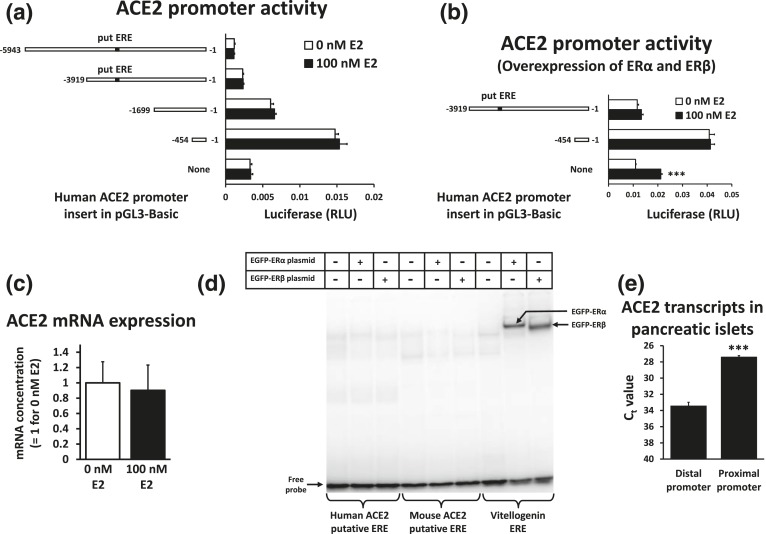Figure 1.
The proximal ACE2 promoter is active in 832/13 cells and pancreatic islets. (a) Luciferase reporters containing human ACE2 promoter segments were transfected into 832/13 cells. A putative ERE (put ERE) is indicated. Transfected cells were treated with 0 or 100 nM estradiol (E2) for 44 hours. (b) Luciferase reporters containing human ACE2 promoter segments were transfected into 832/13 cells together with 0.5 μg EGFP-ERα and 0.5 μg EGFP-ERβ expression plasmid per well. A put ERE is indicated. Transfected cells were treated with 0 or 100 nM estradiol (E2) for 44 hours. ***P < 0.001 vs 0 nM E2. (c) 832/13 cells were transfected with EGFP-ERα and 0.5 μg EGFP-ERβ expression plasmids and subsequently treated with 0 or 100 nM E2 for 48 hours in four experiments. The content of ACE2 mRNA relative to β-actin mRNA was determined. (d) An EMSA was done with the probes for the put EREs from the mouse and human ACE2 promoters as well as the ERE from the vitellogenin A2 gene. Nuclear extracts were from 832/13 cells that were untransfected or transfected with either EGFP-ERα or EGFP-ERβ expression plasmids and grown in the presence of 100 nM E2. (e) In mouse pancreatic islets, the concentration of ACE2 mRNA with transcriptional initiation in the distal and proximal promoter regions was compared with specific Taqman-based quantitative reverse transcription polymerase chain reaction assays. Islets were isolated from four mice. The cycle threshold values (Ct) for the same threshold with RNA diluted to 20 ng/µL are indicated. ***P < 0.001 vs distal promoter region. RLU, relative light unit.

